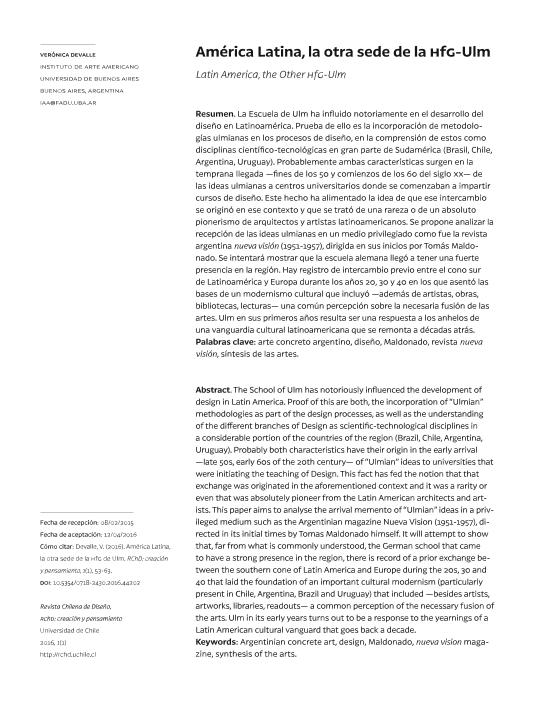Mostrar el registro sencillo del ítem
dc.contributor.author
Devalle, Veronica Estela

dc.date.available
2018-09-18T21:51:05Z
dc.date.issued
2016-11
dc.identifier.citation
Devalle, Veronica Estela; América Latina, la otra sede de la HfG-Ulm; Universidad de Chile. Facultad de Arquitectura y Urbanismo; RChD; 1; 1; 11-2016; 51-61
dc.identifier.issn
0719-837X
dc.identifier.uri
http://hdl.handle.net/11336/60191
dc.description.abstract
La Escuela de Ulm ha influido notoriamente en el desarrollo del diseño en Latinoamérica. Prueba de ello es la incorporación de metodologías ulmianas en los procesos de diseño, en la comprensión de estos como disciplinas científico-tecnológicas en gran parte de Sudamérica (Brasil, Chile, Argentina, Uruguay). Probablemente ambas características surgen en la temprana llegada - fines de los 50 y comienzos de los 60 del siglo XX- de las ideas ulmianas a centros universitarios donde se comenzaban a impartir cursos de diseño. Este hecho ha alimentado la idea de que ese intercambio se originó en ese contexto y que se trató de una rareza o de un absoluto pionerismo de arquitectos y artistas latinoamericanos. Se propone analizar la recepción de las ideas ulmianas en un medio privilegiado como fue la revista argentina nueva visión (1951-1957), dirigida en sus inicios por Tomás Maldonado.
Se intentará mostrar que la escuela alemana llegó a tener una fuerte presencia en la región. Hay registro de intercambio previo entre el cono sur de Latinoamérica y Europa durante los años 20, 30 y 40 en los que asentó las bases de un modernismo cultural que incluyó - además de artistas, obras, bibliotecas, lecturas - una común percepción sobre la necesaria fusión de las artes. Ulm en sus primeros años resulta ser una respuesta a los anhelos de una vanguardia cultural latinoamericana que se remonta a décadas atrás.
dc.description.abstract
The School of Ulm has notoriously influenced the development of design in Latin America. Proof of this are both, the incorporation of “Ulmian” methodologies as part of the design processes, as well as the understanding of the different branches of Design as scientific-technological disciplines in a considerable portion of the countries of the region (Brazil, Chile, Argentina, Uruguay). Probably both characteristics have their origin in the early arrival —late 50s, early 60s of the 20th century— of “Ulmian” ideas to universities that were initiating the teaching of Design. This fact has fed the notion that that exchange was originated in the aforementioned context and it was a rarity or even that was absolutely pioneer from the Latin American architects and artists. This paper aims to analyse the arrival memento of “Ulmian” ideas in a privileged medium such as the Argentinian magazine Nueva Vision (1951-1957), directed in its initial times by Tomas Maldonado himself. It will attempt to show that, far from what is commonly understood, the German school that came to have a strong presence in the region, there is record of a prior exchange between the southern cone of Latin America and Europe during the 20s, 30 and 40 that laid the foundation of an important cultural modernism (particularly present in Chile, Argentina, Brazil and Uruguay) that included —besides artists, artworks, libraries, readouts— a common perception of the necessary fusion of the arts. Ulm in its early years turns out to be a response to the yearnings of a Latin American cultural vanguard that goes back a decade.
dc.format
application/pdf
dc.language.iso
spa
dc.publisher
Universidad de Chile. Facultad de Arquitectura y Urbanismo
dc.rights
info:eu-repo/semantics/openAccess
dc.rights.uri
https://creativecommons.org/licenses/by-nc-sa/2.5/ar/
dc.subject
Diseño
dc.subject
Hfg Ulm
dc.subject
America Latina
dc.subject
Historia
dc.subject.classification
Otras Artes

dc.subject.classification
Arte

dc.subject.classification
HUMANIDADES

dc.title
América Latina, la otra sede de la HfG-Ulm
dc.type
info:eu-repo/semantics/article
dc.type
info:ar-repo/semantics/artículo
dc.type
info:eu-repo/semantics/publishedVersion
dc.date.updated
2018-09-14T13:17:05Z
dc.journal.volume
1
dc.journal.number
1
dc.journal.pagination
51-61
dc.journal.pais
Chile

dc.journal.ciudad
Santiago
dc.description.fil
Fil: Devalle, Veronica Estela. Consejo Nacional de Investigaciones Científicas y Técnicas. Oficina de Coordinación Administrativa Ciudad Universitaria; Argentina
dc.journal.title
RChD
dc.relation.alternativeid
info:eu-repo/semantics/altIdentifier/url/https://rchd.uchile.cl/index.php/RChDCP/article/view/44202/
dc.relation.alternativeid
info:eu-repo/semantics/altIdentifier/doi/http://dx.doi.org/10.5354/0719-837X.2016.44202
Archivos asociados
